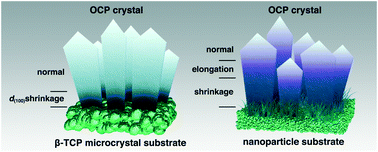Nanoparticles in β-tricalcium phosphate substrate enhance modulation of structure and composition of an octacalcium phosphate grown layer†
Abstract
A c-axis oriented octacalcium phosphate (Ca8(HPO4)2(PO4)4·5H2O; OCP) layer was fabricated on a compression-molded substrate of β-tricalcium phosphate (β-Ca3(PO4)2; β-TCP) particles immersed in a calcium phosphate solution (weakly acidic to basic pH; body temperature). Transmission electron microscopy showed that OCP grew directly on β-TCP when the substrate consisted of microcrystals. The structure and chemical composition (calcium/phosphate molar ratio) of OCP were modulated by interplanar distance shrinkage of the (100) plane, d(100), during the initial growth stages. While the d(100) soon recovered to an ideal value with growth, the modulation of the chemical composition recovered over a long period. The d(100) shrinkage is attributed to the lack of an HPO4–H2O layer in the OCP structure. When the substrate consisted of nanoparticles, hydroxyapatite (Ca10(PO4)6(OH)2; HAP) crystals first grew on the substrate, and then OCP crystals overgrew them. The structure and chemical composition of OCP showed modulation similar to that of the microcrystal substrate during the initial stages. Slight elongation of d(100) was inversely observed during the later stages, and recovery of composition modulation took longer than that with the microcrystal substrate. Nanoparticles in the β-TCP substrate showed evidence that they enhance the structure and chemical composition modulations in OCP.



 Please wait while we load your content...
Please wait while we load your content...